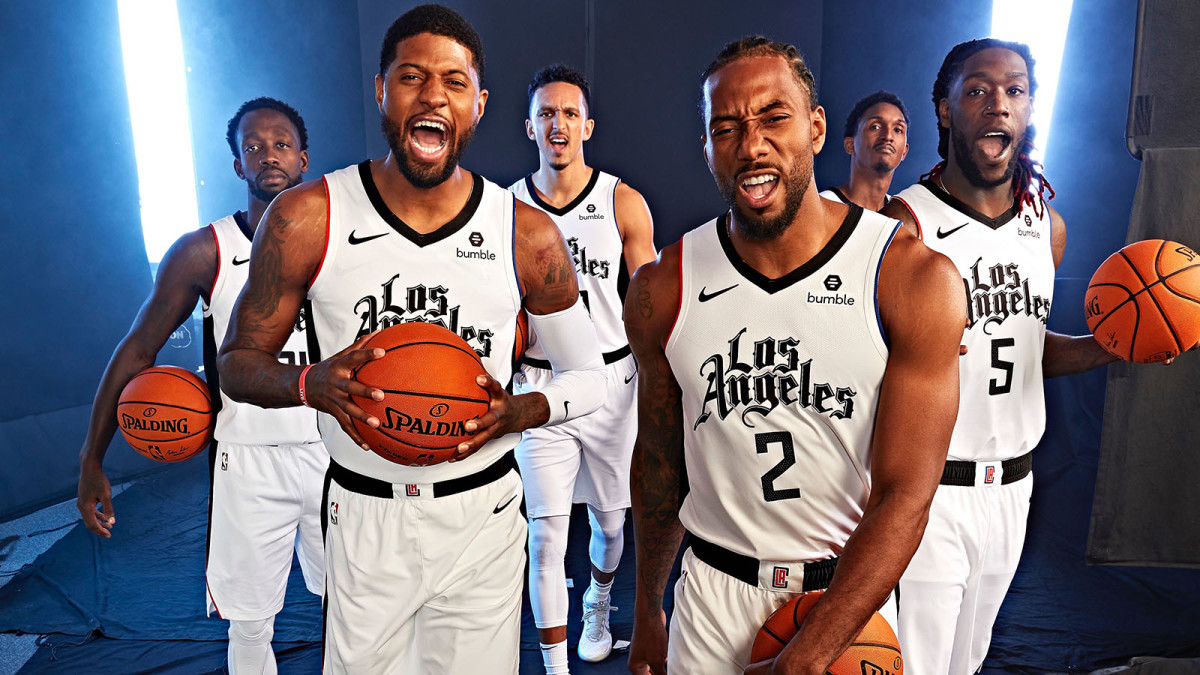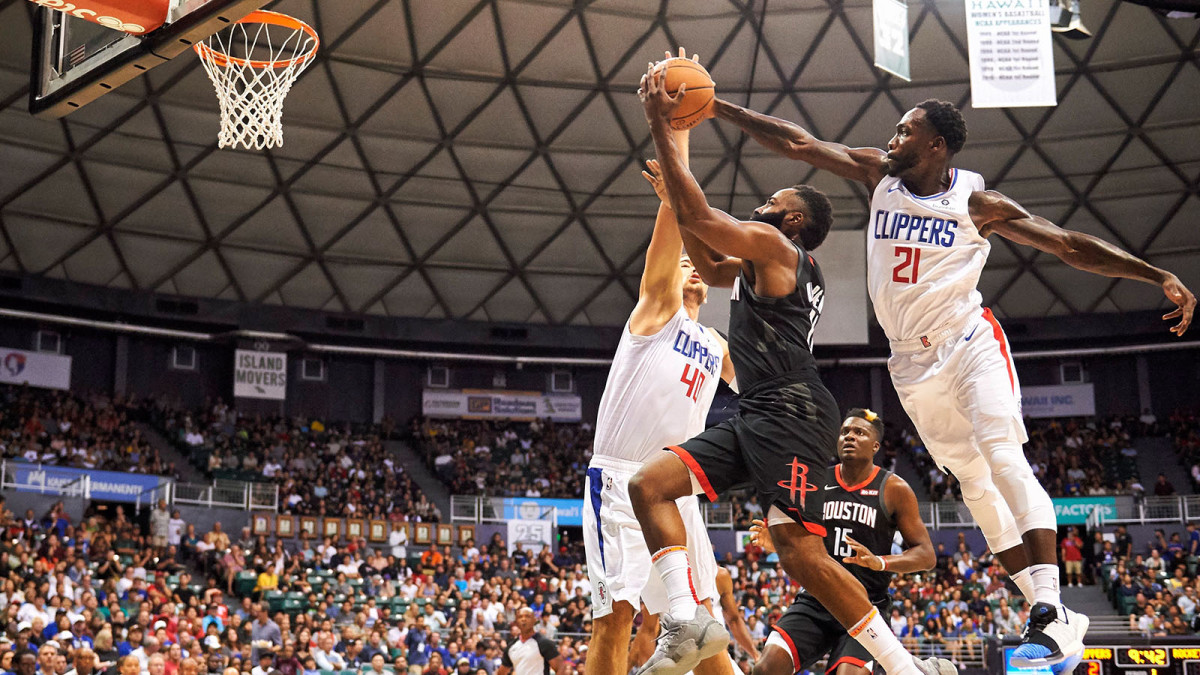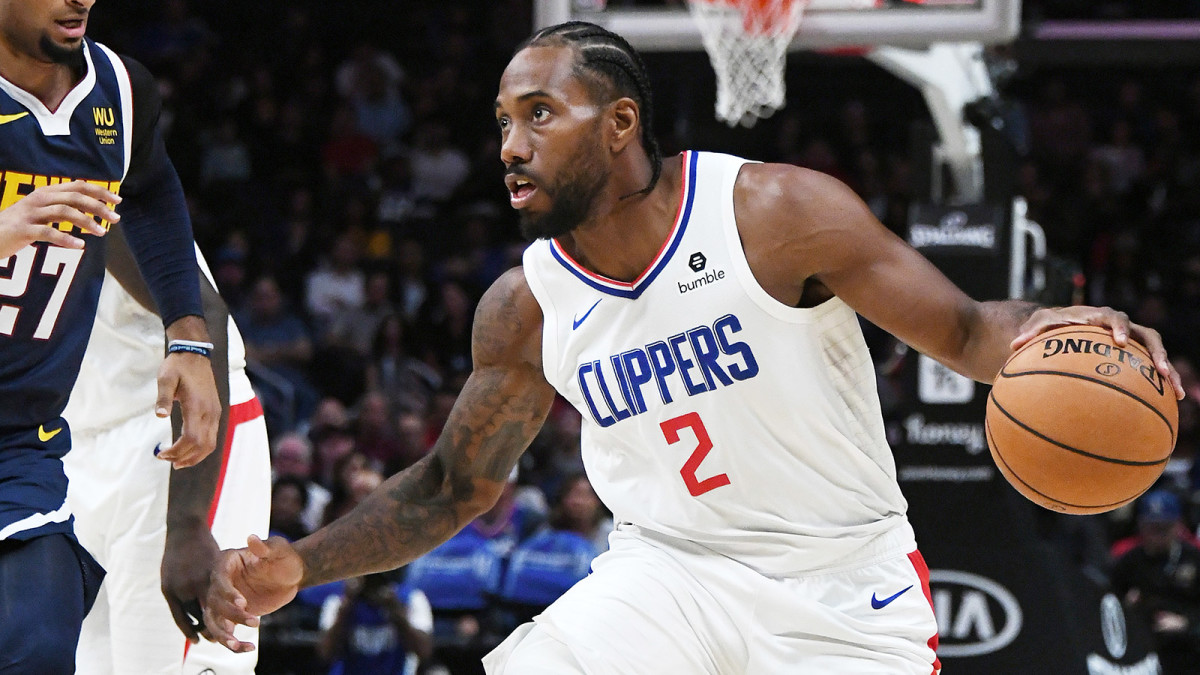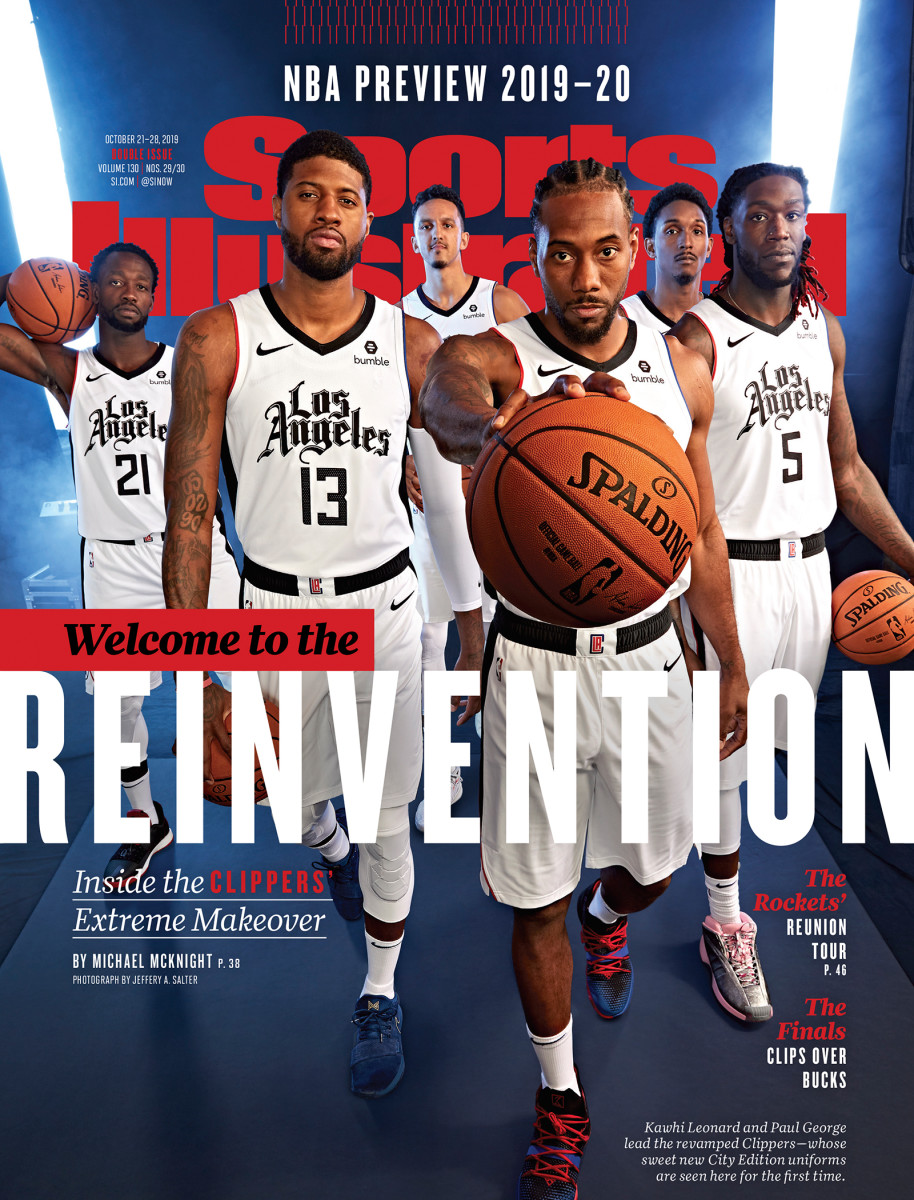Inside a Movement: How the Clippers Pulled Off the NBA’s Biggest Makeover


On the First Friday in October, Clippers guard Patrick Beverley sat lounging in Waikiki, pontificating near the midday surf. “To live in L.A. and root for the Clippers, you have to be a different type of person,” he said. “We haven’t won anything, we don’t have banners, we don’t have our own arena.” Just then, backcourt-mate Landry Shamet strolled by and invited Beverley to join the surfing lesson he’d scheduled. Beverley took a rain check.
“To live here,” Beverley continued, speaking as if he were standing on Figueroa Street instead of the Clippers’ Hawaiian training camp, “to be born and raised here and be a Clipper fan and have to go through that every day—think about that. That’s a constant battle. Those are the type of fans we have.”
After the previous day’s practice at the University of Hawaii–Manoa, coach Doc Rivers said, “When you run into a Clipper fan who’s been one for 20 years, can you imagine what he’s seen?” Rivers chuckled in his trademark rasp, perhaps thinking of the Danny Manning era that never was, or of the franchise’s swing-and-miss on 1998 No. 1 draft pick Michael Olowokandi, or the shame of the Donald Sterling tapes. “We’ve never retired a player’s jersey—and this franchise is almost 50 years old.
“I just feel like we should own our past, own our history. Look at this group of players,” he said as Beverley hoisted postpractice threes, Lou Williams and Montrezl Harrell stretched, new forward Paul George rapped with 81-year-old Hall of Famer [and Clips’ consultant] Jerry West, and Kawhi Leonard took it all in like a Sphinx. “They’re a bunch of survivors, a bunch of loyalists who at some point had to bet on themselves.”
“That’s exactly it,” George says four days later. “This is a blue-collar organization. We got the nightlife, we got the L.A. scene—everything about it—but this group is hardworking and just gritty. That’s how I started my career off, in Indiana. That’s how I made it in this league. So I feel at home.”
The 29-year-old six-time All-Star was standing on the LAC logo at center court inside the team facility, having just completed a noncontact workout on his first day back from Hawaii, preparing his surgically repaired shoulders for the season. George was a surprise addition on July 5, an offshoot of the late-night free agency coup that brought the game’s top free agent, Leonard, to the Clippers. The two stars’ commitment to join the most-hapless franchise in pro sports jostled the NBA chessboard like the 7.1 earthquake that tossed the city that same evening.
“It wasn’t about July 5,” Clippers president of basketball operations, Lawrence Frank, said in Honolulu, sitting unshaven and baseball-capped by the sea. “It was about all the days, over two years, preceding July 5.
“July 5 was just the execution date.”
*****
Each member of the front office is reluctant to discuss the daring no-look passes they have attempted since 2016, when longtime friends Rivers and Frank agreed that the latter should take the reins of basketball operations and let Rivers just coach. They’d rather not discuss the thunderous finish they slammed home on July 5.
Frank, who served stints as head coach of the Nets and the Pistons between 2003 and ’13, says, “I don’t need a f‑‑‑ing word ever written about [the front office]. Ultimately it’s about our players. You see all these organizational charts; some are I-formations, some are T-formations. Ours, the players are in the middle and we’re all just spokes in the wheel. Ownership, coaching, front office, performance and medical, scouts, we’re all serving one thing. My wife joked one time, ‘It should be called the back office.’ And she’s right.”
Frank began building his back-office roster by hiring first-time GM Michael Winger, a bald, 39-year-old salary-cap whiz with a nose for talent and an eye for detail (Clippers ball boys better know how to pass during warmups), and assistant GM Trent Redden, who had worked with Winger in Cleveland. Frank added another assistant GM, a scouting and player-relations expert named Mark Hughes who, at a muscular 6' 8", has been known to post up overconfident young Clippers after practice. Frank had never met any of them before interviewing them. “It’s not like he brought his buddies in,” says one NBA executive. “He wanted the best fits, and no drama.”
They all work for the players, and for Steve Ballmer, the wealthiest owner in the NBA (by a wide margin) and the 19th wealthiest person in the world. The energetic former Microsoft tycoon, who once had surgery on his vocal cords due to his overshouting, is defined by his intellect, creativity and willingness to try anything once. In that spirit, Ballmer last year conspired with Frank to hire Lee Jenkins, author of dozens of thoughtful NBA profiles for this magazine, as the team’s executive director of research and identity, a funky title that asks him to contribute to roster strategy and make every aspect of the franchise attractive to future players. Jenkins likes to point out that meetings at Clippers HQ often include “a dunk champion [Dee Brown, VP of integrated development and evaluation] and a rocket scientist [director of research and analytics Gregory Peim, a Ph.D. in theoretical physics].”
The player development staff includes Natalie Nakase, a 5' 2" former UCLA point guard who a few years back paid her own way to coach a professional men’s team in Japan. “The way Pat [Beverley] plays, that’s the way I played,” Nakase says. “I picked up 94 feet, used my [size] as an advantage. Might as well bother the ball, right?”
A diverse, intelligent workplace culture is all well and good, but by Frank’s second year, the hub of the Clips’ organizational chart had stopped rolling. Despite owning the NBA’s third-best record from 2012–13 through ’16–17, “it was clear to management and to our players that we were not going to hop to that next level,” says Ballmer. “It was Chris Paul—his decision, not ours—his decision to say, ‘Hey I’d love to go [play someplace else].’ That lit the match.”
The Clippers sent the All-Star guard to Houston in June 2017 and in return received three players who have become known as “the Paul Haul,” or as Jenkins calls them, “the Founding Fathers of this era of Clippers basketball.”

Beverley had survived an ugly banishment from the University of Arkansas and relegation to the pro leagues of Ukraine and Greece to craft himself into the peskiest defensive guard alive. Harrell is a floor-running big who loves hoops as much as Frank, loves it so much he runs the courts in Venice Beach in midseason. And Williams—Lou was Lou, the underground GOAT, a former mixtape star who last season became the highest-scoring bench player in NBA history. When the Rockets dealt him to L.A., Lou cried, and not with happiness. “I came to this team at a time in my career when I didn’t know which way was up,” the 32-year-old Williams says. “I thought I was done, at the end of the road, and Doc and this Clippers organization, they revitalized me.”
The team’s win total dropped from 51 to 42 in 2018 (Beverley suffered a season-ending knee injury in November), but the arrival of the Paul Haul “helped set the tone culturally,” Ballmer says. The team began wearing its black uniforms more regularly, for one thing, establishing its own brand of L.A. noir. Moreover, the toughness of Beverley, Harrell and Williams guaranteed that a team that went this hard could never be embarrassed on the floor, no matter how outmatched they were. Their influence reached throughout the organization. “We were willing to invest long term,” says Ballmer. “We were willing to grind, and we were willing to be bold.
“Owners don’t necessarily propose bold moves,” he continued, “but nobody’s gonna trade Blake Griffin without saying, ‘Hey Steve, let’s at least talk about it in advance.’ ”
Seven months after dealing Paul, the Clippers sent Griffin, their leading scorer and the most identifiable player in franchise history, to the Pistons, in a deal that, like the Leonard-George pact, was finalized in the wee hours.
They weren’t tanking—Ballmer insisted the team remain competitive—but for the second straight season they had jettisoned their most expensive player, in this case for a package highlighted by Tobias Harris and a draft pick they flipped into Shai Gilgeous-Alexander. “We were betting on our future,” says Winger, the GM. “We were betting on our ability to position ourselves in two or three years to open that window. But it was all hypothetical then, it was all just theory.”
*****
Their stealthy preparations for the 2019 offseason included trading Rivers’s son, for crying out loud. “I said, ‘Listen, we gotta do it,’ ” Rivers says of shedding Austin Rivers’s $11 million salary in June ’18. “It was the hardest call of my life.” Meanwhile, Harris was becoming a star, and the Clippers would soon find themselves on a surprising 50-win pace.
“Despite the fun, despite the run, despite the extraordinary chemistry that team had,” says Winger, “we had to again get in our cave and shine the light on ourselves, on our roster, our future, and have another hard conversation.” Harris was about to become a free agent, and he wouldn’t come cheap.
So Winger completed a deal to send “the kindest, most respectful player you’ll ever meet,” to Philadelphia at the trade deadline last February. Just before the trade was announced, Harris hit a game-winning jumper to beat the Hornets. “It ripped our hearts out,” Winger recalls, “but we had to honor the plan.” The blow was softened by the knowledge that Harris would play for a contender. The Sixers are good people, Winger thought, he’s from New York, he’ll be closer to home. “It was a good fit for Tobias. That mattered to us.”
The Clippers made two more deals at the deadline, obtaining forwards JaMychal Green and Garrett Temple from the Grizzlies, and center Ivica Zubac from the Lakers—the first trade between those two teams since the Clippers moved north from San Diego in 1984. When the Clips arrived in Boston for their Feb. 9 game against the Celtics, Zubac was waiting for them at the hotel that the Lakers had just checked out of. The Clippers fell behind by 28 points that night before Shamet, one of the new guys from Philly, hit four threes in the fourth quarter to push the Clippers past Boston, 123–112. “He was running to the bench looking for hugs,” Winger recalls, “and the other guys are like, Yeah, we did it! Who are you?”
The win kickstarted an 18–8 run to close out the regular season. The sum of these moves might have portended the shrewdness to come, if the NBA had been paying closer attention. The only thing the Clippers had built, after all, was an eight-seed.

On the night the Clippers dealt Griffin to Detroit, back in January 2018, Kawhi Leonard was sitting out yet another game for the Spurs with a quadriceps injury. Portrayed as broken and brooding, Leonard listened to Spurs teammates and officials suggest that he seemed to be in no rush to get back on the floor. Leonard never wore a Spurs jersey again.
He played only nine games that year, scoring 146 points—25 fewer than he would score against the Warriors in the 2019 NBA Finals, where he rewarded the Raptors, the team that took a chance on him and his healed leg, with a Larry O’Brien Trophy.
Suddenly, Leonard was being compared, by one of the most respected coaches in the league, with Michael Jordan. Rivers was fined $50,000 for that May 31 remark, deemed a violation of the league’s tampering rules, but no one blinked at the comparison. The moral: Fates can change quickly in the NBA. And no team’s future stood to be reshaped more dramatically than the one that had patiently amassed an estimated $59.7 million in cap space—the team that drew the Warriors as their first-round opponents in the playoffs. This was back when Kevin Durant’s right Achilles tendon was intact and he was the top free agent in his class, seemingly destined to sign with the Knicks, the only team other than the Nets with more cap room than the Clippers.
Durant would score 50 points in the Game 6 clincher, but the Clippers’ rotation, which featured the likes of Temple and Jerome Robinson, had not only hung with the defending champs, it had taken two games from them. Despite their elimination, those six games amounted to a Clippers ad campaign aimed at the best players in the league. We’re some dogs. Join us.
Something else happened during that series. Winger, the Clippers’ limelight-averse GM, declined to interview for the president of basketball ops position in Minnesota. The reason, says the Ohioan turned Angeleno, was that “there’s a sense of responsibility that comes with being added to this group. . . . Our front office was passionate and humble, and wanted to be a part of something special. They wanted their work to have purpose.”
*****
The call came from mayor Eric Garcetti just prior to the 2018 All Star game in Los Angeles. “Leading up the Olympics, his goal was to make L.A. the healthiest city in America by providing every kid with access to youth sports,” says Gillian Zucker, the Clippers’ president of business operations (and Ballmer’s first hire when he assumed ownership in 2014). The mayor asked the Clippers to help. City hall had ordered an audit of every public basketball facility in L.A., indoor and outdoor, to determine their condition. The results “came in these gigantic binders,” Zucker says. “I wrote up a memo and gave [the binders] to Steve. He was headed out on a flight somewhere.
“When he landed, he called me and said, ‘Let’s do them all.’ ” Today there are around 150 courts throughout greater L.A. that have new rims, new flooring and an interlocked LAC in the center circle, and by the end of 2020 there will be 348.
The Clippers have also bankrolled a mobile optometry shop that shows up at local schools to test kids’ vision and fit them with glasses. “More than 30% of kids in public schools deal with vision issues,” Zucker says. “They are put in special classes, or [misdiagnosed as having] a learning disability, when all they need is glasses.” That program started with five schools in Watts, then the entire Inglewood school system (12,000 students), then Long Beach (71,000). About two years ago the mobile eyewear shops began serving the 670,000 students of L.A. Unified School District.
Beverley leaped on another opportunity that will be unveiled this season. In partnership with an L.A.-based tech company called Honey, the team will set aside 50 to 200 tickets before each home game, price them at $10 each and sell them to red-and-blue-clad fans outside Staples, under the tenet that Clips games shouldn’t only be accessible to the financially secure.
When the Clippers re-signed Beverley in early July, Leonard took notice. So did another player who wasn’t even on the market.
“As the season wound down,” Frank says, “we were very transparent that Kawhi was going to be our No. 1 target.” Frank sent staffers—even Ballmer—to Raptors games to make the team’s interest apparent as much as to scout. “We locked in, and we weren’t hiding it.”
When the time came to meet with Leonard and his family, Frank was heartened to learn that “Kawhi loved our guys. He went through each player, he knew their games.” Afterward, though, the Clippers were forced to sweat out Leonard’s meeting with the Lakers while formulating their own Plan B.
It was three straight days of takeout and coffee orders, with Frank, Winger and the rest of the back office holing up until two in the morning, then returning at six after dashing to their respective homes in the South Bay area to shower. “The back-and-forth, the phone calls, the different conversations to keep everyone in the loop,” Frank recalls. “We had our whole front office in this little room, at some point I think the air conditioning didn’t work, it’s sweaty as s---, then there’s a f---ing earthquake, the building is shaking, [we’re] talking to Steve, talking to Doc, talking to Jerry, getting everyone’s input. . . .”
Finally, Leonard let them know that they didn’t just have a deal; George wanted in too. The Clippers’ back office pieced together a trade with Oklahoma City, and fast. The end result, says Frank, “was unbelievable excitement and joy, but then you have the pain of having to call Shai”—who had played brilliantly in 82 games as a rookie—“and Shai’s mom, Charmaine. And we had to tell Gallo [forward Danilo Gallinari]” that he’d be joining Gilgeous-Alexander in Oklahoma City.
“Here’s Shai, he’s a 20-year-old, we never thought we’d trade him, but he’s like, ‘You traded me for Paul George? Yeah, I get that. It’s Paul George.’ ”
It was the final, critical step in a three-year expedition. “You want to make sure everything is handled the right way,” says Frank, “managing the information, letting people know in the right order, at the right time. One thing our group prided itself on is that none of our stuff got out.
“We learned some things when we traded Blake,” Frank adds solemnly, reflecting on the 2018 deal in which feelings were hurt unnecessarily, “things we could get better at.”
Beverley was in Las Vegas, at Carbone restaurant with Williams. “My ex-teammate, Chandler Parsons, gave me the news like I was part of the deal,” Beverley says. “ ‘You guys got Kawhi and Paul George; I’m pretty sure you got traded.’ ”
Meanwhile, back in that tight office in El Segundo, someone found half a bottle of Chopin potato vodka and some red Solo cups for a toast that went click instead of clink. Within four hours, they were back at it, working on a new contract for JaMychal Green.
Beverley and Williams were up early, too, working out and getting shots up at UNLV with assistant coach Sam Cassell. “We already had a burning fire in us,” says Beverley, “but when you get news like that you wanna prepare, get your swords sharpened, make sure s--- is intact.” Then Trez showed up at Thomas & Mack Arena wearing a 1990s-era Clippers jersey, its loopy white cursive having been synonymous for decades with doormat.

The new city edition uniforms that Harrell and the Clippers will debut this season were designed in collaboration with Mr. Cartoon, the renowned L.A. tattoo artist and cultural touchstone, as yet another nod to the franchise’s connection to that side of the city that isn’t the Malibu-Hollywood cliché the media foists upon the world. They will be worn by a team that now boasts the most intriguing two-way wings in the game, a team that will enter 2020 with a defense-creates-offense identity constructed around Leonard and George, SoCal natives both. But what the franchise truly aspires to extends beyond the roster.
“This is the happiest I’ve ever been,” says the 49-year-old Frank, “because it’s so damn stimulating. In coaching, you have the opportunity to impact 15 players and their families. Here, we can impact 80 people and their families.” With the opportunity to influence millions more.
“We went to Kawhi after someone approached us about donating backpacks to foster and homeless kids,” says Zucker. “We learned there were 140,000 kids who needed backpacks for the start of the school year. Then we realized that if we gave backpacks to those kids, they’d be walking around with something that branded them as needing help. So we decided, Let’s just give backpacks to everybody.”
When she mentioned it to Leonard, he suggested they start by handing them out in Moreno Valley, where he grew up.
“About a month ago, we started our morning in Moreno Valley and made an announcement that we’d be giving a backpack to every child in the Riverside County school system,” Zucker recalls. She whispered to Leonard that she had brought the Clippers’ mascot, Chuck the Condor, along so the team’s new star wouldn’t have to hand out 350 backpacks. Leonard insisted on doing it himself. Then they drove to 107th Street Elementary in South L.A., and announced that they’d be giving a backpack to each child in LAUSD. By Christmas, a million backpacks will be distributed all over the region.
“This whole thing feels like a movement,” says Rivers. “Us and the fans. That’s how I feel. A movement gathers supporters, it gathers steam. My God, I never thought we could get that going. We had a really good team with Blake and Chris and DJ [DeAndre Jordan], but we couldn’t get the movement going. And now it has really taken hold. We’re moving, we’re grabbing people [to go] along with us. And we’re just getting started.”
